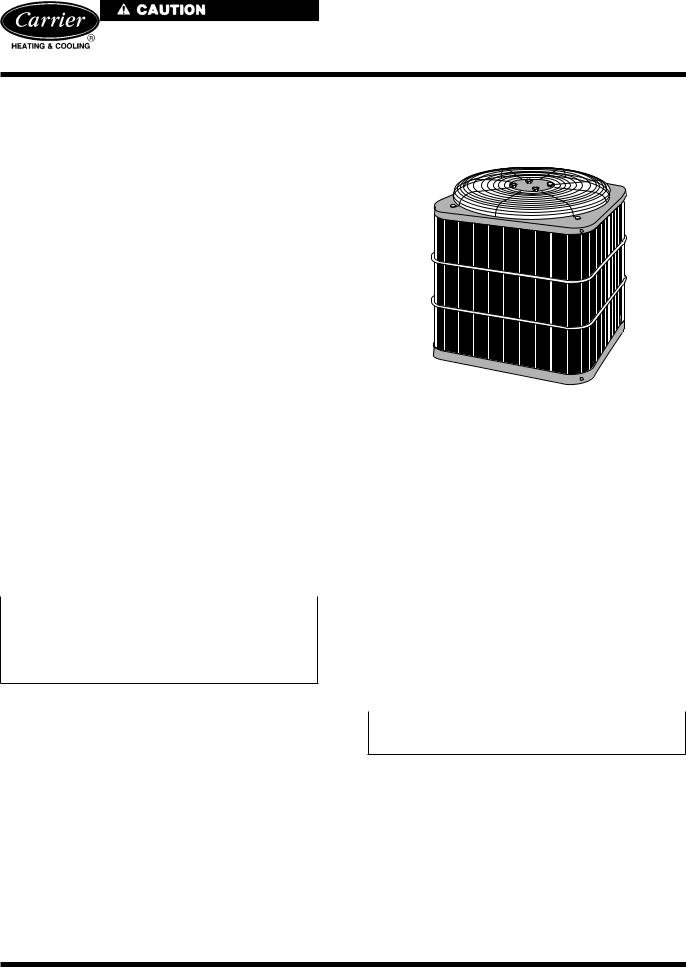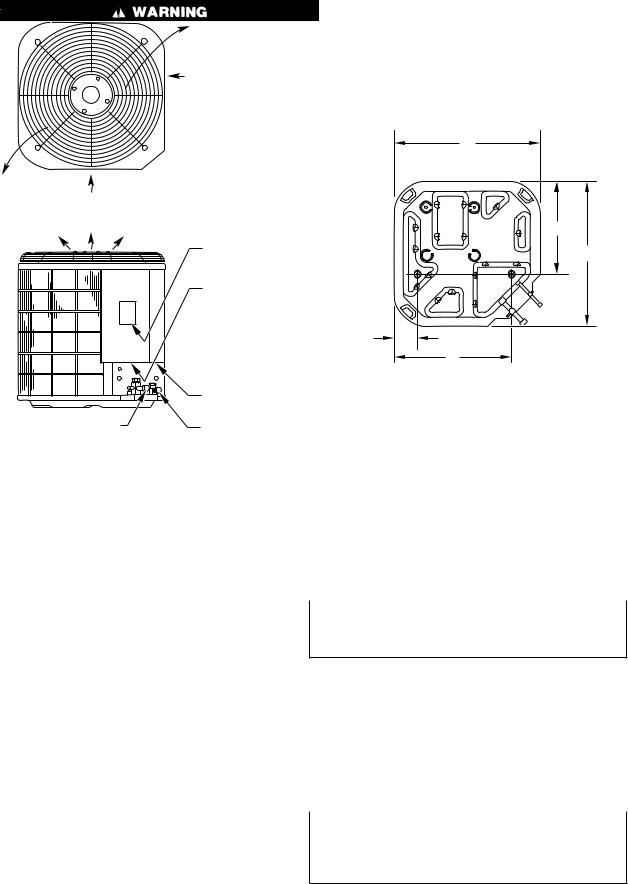Carrier 38CKB User Manual

38CKBÐ50 Hz Air Conditioning Unit
Installation and Start-Up Instructions
NOTE: Read the entire instruction manual before starting the installation.
SAFETY CONSIDERATIONS
Improper installation, adjustment, alteration, service, maintenance, or use can cause explosion, fire, electrical shock, or other conditions which may cause death, personal injury, or property damage. Consult a qualified installer, service agency, or your distributor or branch for information or assistance. The qualified installer or agency must use factory-authorized kits or accessories when modifying this product. Refer to the individual instructions packaged with the kits or accessories when installing.
Follow all safety codes. Wear safety glasses, protective clothing, and work gloves. Use quenching cloth for brazing operations. Have fire extinguisher available. Read these instructions thoroughly and follow all warnings or cautions included in literature and attached to the unit. Consult local building codes and national electric codes for special requirements.
Recognize safety information. This is the safety-alert symbol  . When you see this symbol on the unit and in instructions or manuals, be alert to the potential for personal injury.
. When you see this symbol on the unit and in instructions or manuals, be alert to the potential for personal injury.
Understand the signal word DANGER, WARNING, or CAUTION. These words are used with the safety-alert symbol. DANGER identifies the most serious hazards which will result in severe personal injury or death. WARNING signifies hazards which could result in personal injury or death. CAUTION is used to identify unsafe practices which would result in minor personal injury or product and property damage.
Before installing, modifying, or servicing system, main electrical disconnect switch must be in the OFF position. There may be more than 1 disconnect switch. Lock out and tag switch with a suitable warning label. Electrical shock can cause personal injury or death.
INSTALLATION
Step 1ÐCheck Equipment and Jobsite
UNPACK UNIT Ð Move to final location. Remove carton taking care not to damage unit.
INSPECT EQUIPMENT Ð File claim with shipping company prior to installation if shipment is damaged or incomplete. Locate unit rating label on unit service panel. (See Fig. 2.) It contains information needed to properly install unit. Check rating label to be sure unit matches job specifications.
Step 2ÐInstall on a Solid, Level Mounting Pad
If conditions or local codes require the unit be attached to pad, tiedown bolts should be used and fastened through knockouts provided in unit base pan. Refer to unit mounting pattern in Fig. 2 to determine base pan size and knockout hole location.
When installing, allow sufficient space for airflow clearance, wiring, refrigerant piping, and service. Allow 30-in. (762mm) clearance to service end of unit and 48 in. (1219mm) above unit.
A94356
Fig. 1ÐModel 38CKB
For proper airflow, a 6-in. (152mm) clearance on 1 side of unit and 12 in. (305mm) on all remaining sides must be maintained. Maintain a distance of 24 in. (610mm) between air conditioners. Position so water, snow, or ice from roof or eaves cannot fall directly on unit.
On rooftop applications, locate unit 6 in. (152mm) above roof surface. Where possible, place unit above a load-bearing wall.
Arrange supporting members to adequately support unit and minimize transmission of vibration to building. Consult local codes governing rooftop applications.
Step 3ÐReplace Indoor AccuRater® Piston, if Required
Check indoor coil piston to see if it matches the required piston shown on unit rating label. If it does not match, replace indoor coil piston with piston shipped with this unit. The piston shipped with outdoor unit is correct for any approved indoor coil combination.
Remove indoor coil piston if unit is to be installed on system with a TXV metering device.
Step 4ÐMake Piping Connections
Outdoor units may be connected to indoor sections using accessory tubing package or field-supplied refrigerant grade tubing of correct size and condition. For tubing requirements beyond 50 ft (15.24m), consult Long-Line Application Guideline which is available at your local distributor.
NOTE: In some cases, noise in the living area has been traced to gas pulsations from improper installation of equipment.
INSTALLATION RECOMMENDATIONS
1.Locate the unit away from windows.
2.Ensure that vapor and liquid tube diameters are appropriate to the capacity of the unit. (See Table 1.)
Manufacturer reserves the right to discontinue, or change at any time, specifications or designs without notice and without incurring obligations.
Book |
1 |
4 |
PC 101 |
Catalog No. 013-862 |
Printed in U.S.A. |
Form 38CKB-C1SI |
Pg 1 |
12-94 |
Replaces: New |
Tab |
3a |
2a |
|
|
|
|
|
|
|

AIR IN
AIR
DISCHARGE
AIR IN
AIR IN 
AIR
DISCHARGE
AIR IN
NOTES:
1.Allow 30 in. (762) clearance to service sides of unit, 48 in.
(1219.2) above unit, 6 in. (152.4) on one side, 12 in. (304.8) on remaining side, and 24 in. (609.6) between units for proper airflow.
2.Minimum outdoor operating ambient in cooling mode is 55 F (12.8 C), max 115 F (46.1 C).
3.Dimensions in parenthesis are in millimeters.
4.Series designation is the 13th position of the unit model number.
A
AIR DISCHARGE |
AIR DISCHARGE |
|
E |
|
|
RATING LABEL |
B |
|
|
|
|
|
|
FIELD POWER |
|
|
|
SUPPLY CONN |
|
|
|
7⁄8 IN. DIA (22.22) HOLE WITH |
|
|
|
1 1⁄8 IN. DIA (28.57) KNOCKOUT |
|
|
|
AND 1 3⁄8 IN. DIA (34.92) KNOCKOUT |
|
|
|
|
C |
|
|
|
D |
FIELD CONTROL
SUPPLY CONN
7⁄8 IN. DIA (22.22) HOLE
F DIA SUCTION LINE CONN |
3⁄8 IN. DIA (9.53) LIQUID LINE CONN |
|
|
|
|
|||||||
|
|
|
|
|
|
|
|
|
|
|
|
A91173 |
|
|
|
|
|
|
|
|
|
|
|
|
|
UNIT SIZE |
|
A/B |
C |
|
|
D |
E |
|
|
F |
||
In. |
|
mm |
In. |
mm |
In. |
|
mm |
In. |
mm |
In. |
mm |
|
|
|
|
||||||||||
018 |
18 |
|
457.2 |
3 |
76.2 |
15 |
|
381.0 |
10-3/16 |
258.8 |
5/8 |
15.9 |
024 |
22-1/2 |
|
571.5 |
3-11/16 |
93.6 |
18-1/8 |
|
460.4 |
14-3/8 |
365.1 |
5/8 |
15.9 |
036 |
22-1/2 |
|
571.5 |
3-11/16 |
93.6 |
18-1/8 |
|
460.4 |
14-3/8 |
365.1 |
3/4 |
19.1 |
048, 060 |
30 |
|
762.0 |
6-1/2 |
165.1 |
23-1/2 |
|
596.9 |
20 |
508.0 |
7/8 |
22.2 |
Fig. 2ÐUnit Reference Drawing
3.Run refrigerant tubes as directly as possible by avoiding unnecessary turns and bends.
4.Leave some slack between the structure and the unit to absorb vibration.
5.When passing refrigerant tubes through the wall, seal the opening with RTV or other pliable silicon-based caulk. (See Fig. 3.)
6.Avoid direct lineset contact with water pipes, ductwork, floor joists, wall studs, floors, and walls.
7.Do not suspend refrigerant tubing from joists and studs with a rigid wire or strap which comes in direct contact with the tubing. (See Fig. 3.)
8.Ensure that tubing insulation is pliable and completely surrounds the vapor tube.
9.When necessary, use hangar straps which are 1 in. (25mm) wide and conform to the shape of the tubing insulation. (See Fig. 3.)
10.Isolate the hangar straps from the insulation by using metal sleeves bent to conform to the shape of the insulation.
If refrigerant tubes or indoor coil is exposed to atmospheric conditions for longer than 5 minutes, it must be evacuated to 500 microns to eliminate contamination and moisture in the system.
To prevent compressor damage DO NOT bury more than 36 in. (914mm) of refrigerant tubing. If ANY tubing is buried, provide 6 in. (152mm) vertical rise at service valve.
OUTDOOR UNITS CONNECTED TO FACTORY-APPROVED INDOOR UNITS Ð Outdoor unit contains correct system refrigerant charge for operation with indoor unit of the same size when connected by 15 ft (4.55m) of field-supplied or factory-accessory tubing. Check refrigerant charge for maximum efficiency.
REFRIGERANT TUBING Ð Connect tubing to fittings on outdoor unit vapor and liquid service valves. (See Fig. 2.)
Relieve pressure and recover all refrigerant before system repair or final unit disposal to avoid personal injury or death. Use all service ports and open all flow-control devices, including solenoid valves.
2
